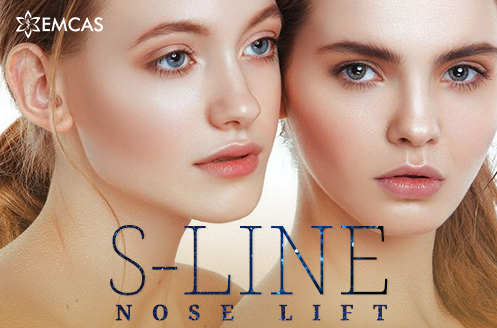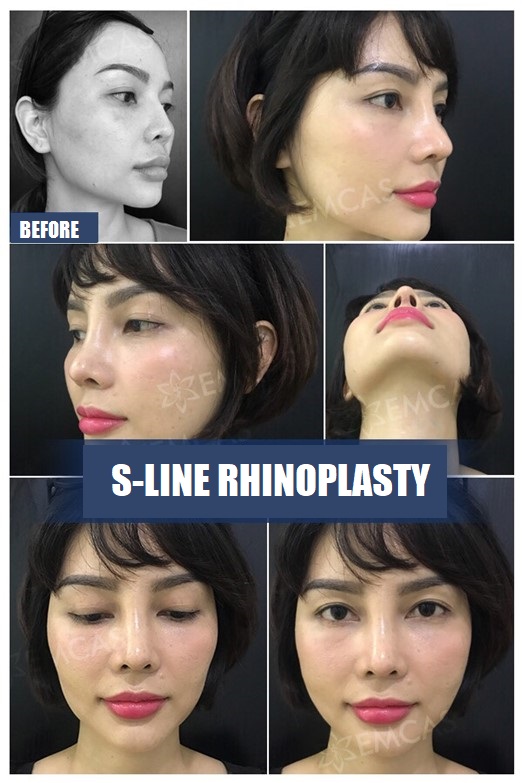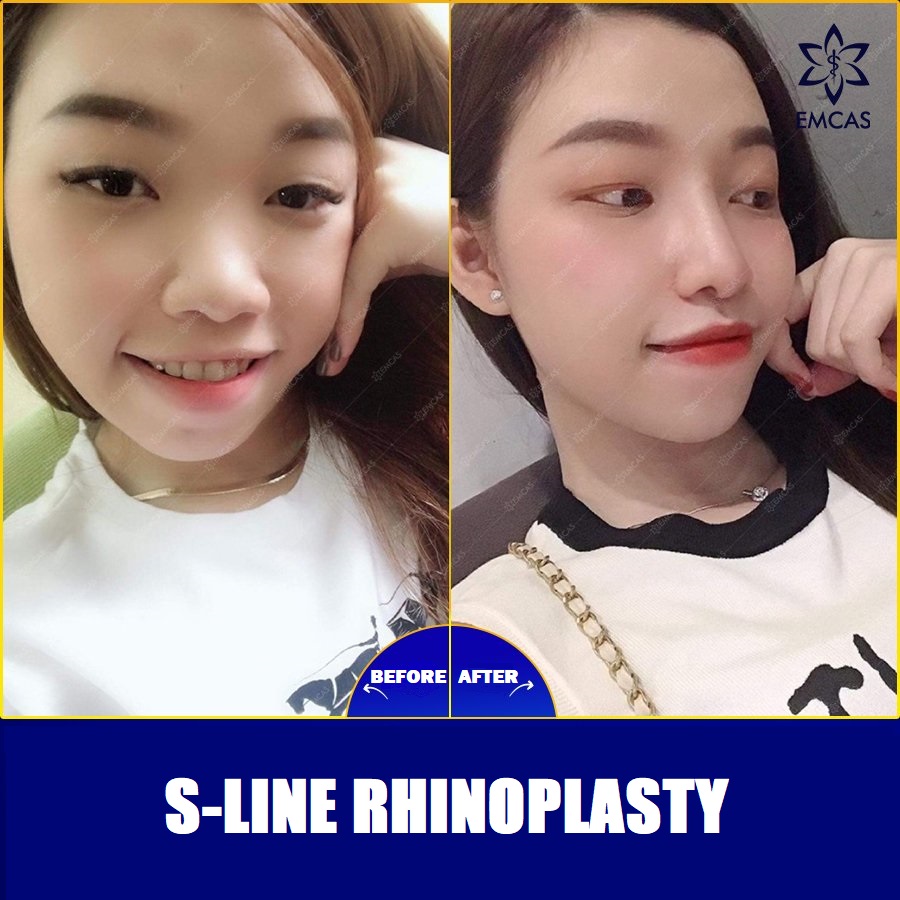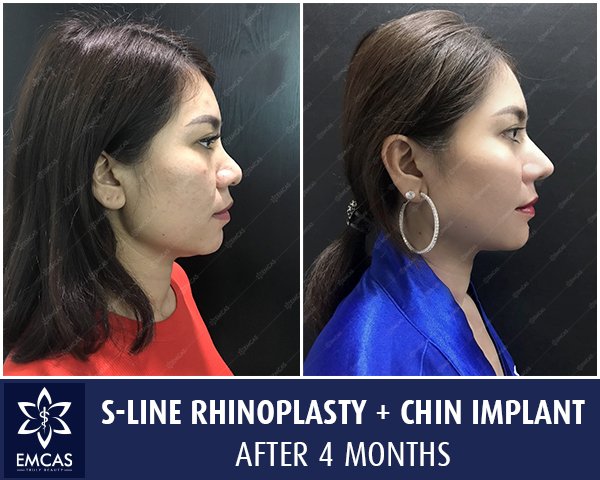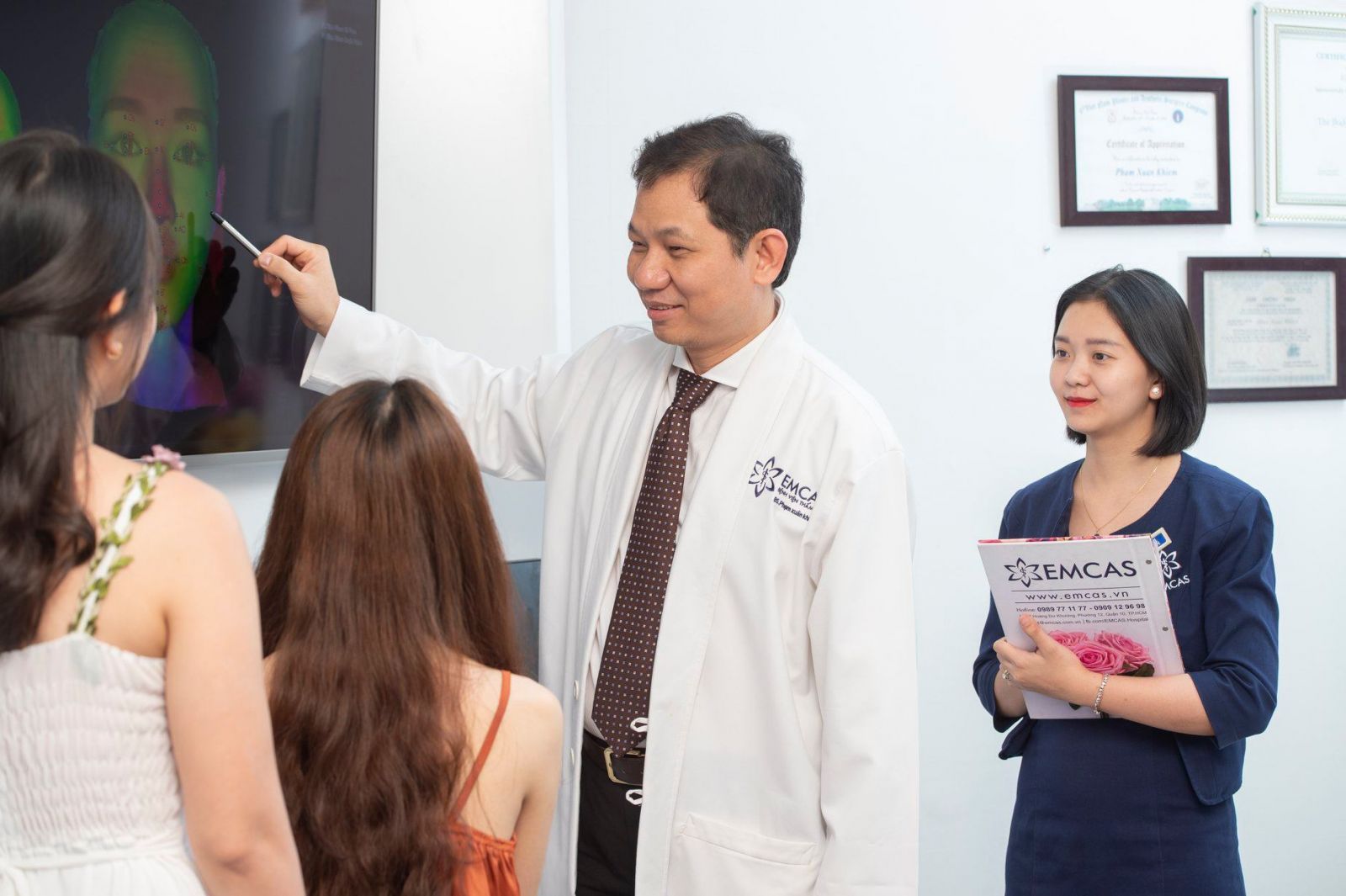Creating an ideal S-line nose which is harmonious with the other favorable facial features
WHAT IS S-LINE RHINOPLASTY
The nose is a central part of the face, creating harmony and balance for the entire face. However, Asians in general and Vietnamese in particular often own low noses, big nose heads, rafts, making their faces quite unbalanced, bringing inferiority to women. Therefore, women are always looking for a perfect solution for their nose.
Thanks to the rapid development of modern Asian plastic surgery technology (first is South Korea and Japan), the traditional rhinoplasty method has been changed. The born of new modern cartilage nasal grafting surgery (often known as S-line nose lift) has helped many Asian people owning a natural beautiful nose shape.
S-line nose lift has many good advantages such as slim nose shape, soft S natural shape etc. A surgeon will restructure your nose, nose tip, nose wings and nose bridge in order to create a harmony look between your nose and your face. Besides, this is also a perfect solution to fix shiny red nose tip, hard nose shape or cases of fallen out nose bridge.
WHY CHOOSE EMCAS

 We perform thousands of procedures every year, helping patients to achieve the look they’ve always wanted. Our surgeons offer in-depth client evaluations to address rhinoplasty concerns and questions
We perform thousands of procedures every year, helping patients to achieve the look they’ve always wanted. Our surgeons offer in-depth client evaluations to address rhinoplasty concerns and questions
 We offer a wide range of cosmetic surgery procedures which can enhance the way you look. Some of our most popular cosmetic procedures include breast enlargement/ augmentation, buttock enlargement, liposuction, tummy tuck, rhinoplasty surgery or face lift.
We offer a wide range of cosmetic surgery procedures which can enhance the way you look. Some of our most popular cosmetic procedures include breast enlargement/ augmentation, buttock enlargement, liposuction, tummy tuck, rhinoplasty surgery or face lift.
 Highly experienced surgeons: Cosmetic or plastic surgery is one that you will live with for the rest of your life. The two most important factors of successful plastic surgery are selecting the right hospital and the right surgeon, who is held to the highest standards of education, training, safety and ethics.
Highly experienced surgeons: Cosmetic or plastic surgery is one that you will live with for the rest of your life. The two most important factors of successful plastic surgery are selecting the right hospital and the right surgeon, who is held to the highest standards of education, training, safety and ethics.
 State-of-the-art facilities: They include hospitals, operating room, outpatient care centers and specialized care centers in the privacy and sterility.
State-of-the-art facilities: They include hospitals, operating room, outpatient care centers and specialized care centers in the privacy and sterility.
The American advanced technology – VECTRA 3D IMAGING SYSTEM will:
+ Capture body images in ultra-high resolution 3D
+ Automated measure, help you understand your current condition
+ Help you to visualize what the potential outcome of your surgery will be.
 Experienced, caring support: We are chosen by thousands of patients to provide them with the best care, from their consultation to surgery and throughout their entire aftercare. Our medical team and administration staffs at EMCAS are here to support you in every step of your journey.
Experienced, caring support: We are chosen by thousands of patients to provide them with the best care, from their consultation to surgery and throughout their entire aftercare. Our medical team and administration staffs at EMCAS are here to support you in every step of your journey.
 We understand that your decision to go ahead with our high quality cosmetic or weight loss surgery shouldn’t be restricted by cost. That’s why we’ve made it easy to estimate the cost of your treatment during consultation and spread the cost with flexible payment options to suit you.
We understand that your decision to go ahead with our high quality cosmetic or weight loss surgery shouldn’t be restricted by cost. That’s why we’ve made it easy to estimate the cost of your treatment during consultation and spread the cost with flexible payment options to suit you.
 Up to 80% of patients at EMCAS have had cosmetic or weight loss surgery after consultation and can share their experiences with you.
Up to 80% of patients at EMCAS have had cosmetic or weight loss surgery after consultation and can share their experiences with you.
WHO SHOULD HAVE S-LINE NOSE LIFT?
- Someone above the age of 18 wants an S-line rhinoplasty. (If people under the age of 18 require parental consent following consulting with EMCAS doctors).
- Should be physically healthy and mentally stable
- Should be a non-smoker
- Have a crooked nose and need to improve the appearance of the nose
- Want to have a permanent solution for nose reshaping
- Whether you have a history of heart failure or other cardiovascular disease, you should think before getting this surgery.
Frequently asked questions (FAQ) about Rhinoplasty:
 Q: Is rhinoplasty a procedure that is permanent?
Q: Is rhinoplasty a procedure that is permanent?
A: Rhinoplasty is reversible in the way that your nose won't change shape on its own as long as your facial features are completely formed. That being said, if necessary, rhinoplasty is also reversible and unpleasant effects can be reversed by revision rhinoplasty.
 Q: What is the difference between open and closed rhinoplasty?
Q: What is the difference between open and closed rhinoplasty?
A: In closed rhinoplasty, all incisions are made inside the nose. This is the most common choice that much of the scarring as minimal as it is—appears on the inside of the nose, as slight as it is. The recovery time is typically much shorter, too. Although some surgeons prefer the closed approach, it also significantly limits the surgical exposure, making it difficult or even impossible to utilize many of today's most effective rhinoplasty techniques.
Incisions inside the nose and a slight incision under the nose near the nostrils are used in open rhinoplasty. It is much better to do this operation than a closed rhinoplasty because it makes it easy for the surgeon to see what they are doing. Although the columellar incision is initially visible, when carefully re-approximated, it seldom results in an objectionable nasal scar and it often fades completely in the months following surgery.
 Q: Can my breathing be improved during rhinoplasty?
Q: Can my breathing be improved during rhinoplasty?A: Facial defects are often responsible for some respiratory difficulties (such as a bent or pinched nose) and proper care may strengthen both appearance and function. Our experienced rhinoplasty surgeon will maintain adequate nasal breathing following cosmetic rhinoplasty, and adequate nasal function should never be intentionally sacrificed for cosmetic improvement. They are therefore able to produce a narrower and more appealing nose while enhancing nasal function at the same time.
For more information about breast surgery, please schedule a consultation with our experienced surgeons
REAL RESULTS
CONSULTATION
- Discuss with your surgeon about what your concerns and your desired outcome, what may or may not be possible given your existing face anatomy, type and skin elasticity; Working with Morpheus and VECTRA XT 3D imaging system to visualize what the potential result of your surgery will be. The objective of rhinoplasty is to bring a sense of proportion and harmony to the face. Your nose will be photographed from different angles. These photos help with planning the surgery, assessing its immediate and long-term effects;
- Comprehensive discussion regarding risks and complications;
- Previous medical history, underlying medical conditions, a complete list of all medications you are taking, birth control, allergies etc. will also be recorded.
PREPARE FOR YOUR SURGERY
- Strictly NO food and drink including water for 6-8 hours before surgery. Having food or drink in your system could cause complications from the anesthesia;
- Stop smoking before your procedure for a few weeks to avoid nicotine-related risks;
- Do not take medications that could increase bleeding, such as non-steroidal anti-inflammatories and aspirin. Avoid supplements that have similar effects, like vitamin E and fish oil;
- Patients shouldn’t undergo a second corrective surgery until their nose is fully healed from the first surgery;
- You must be cleared for surgery by appropriate pre-surgery screening (blood test, EKG, X-ray, ultrasound etc.) in accordance with your surgeon's instructions and our Patient Safety requirements;
- Choose clothes that will be comfortable (loose-fitting clothes and slip-on shoes). You shouldn't wear contact lenses, accessories like jewelry, watches, wigs or hairpins. Do not apply any products to your skin or hair the morning of surgery;
- Line up a family member or friend to drive you home after your procedure or post-operative care since you will be receiving anesthesia.
PROCESS
Depending on the complexity of the procedure, you may be under general anesthesia or local anesthesia with sedation. Rhinoplasty may be done at the base of the nose (between the nostrils) or from inside the nose by a minor surgical incision. The surgeon will change the location of the bone and cartilage under the skin for your desired purposes.
The surgeon may use extra cartilage from the nose itself or other donor locations, depending on the extent of the nasal reconstruction. Implants can also be used as well. If the patient has a deviated septum, this can also be corrected during the operation by the surgeon. The surgeon will reposition the skin and tissue after the changes are made, and stitch the incision closed.
CARING & ROUNTINE CHECKUPS AFTER RHINOPLASTY
 Right after the procedure: You will have caring services: checking up, giving medicines, bandage changing, advising, supporting frequently through hotline by EMCAS's customer service staffs. You must stay at hospital in the first 1-2 hours.
Right after the procedure: You will have caring services: checking up, giving medicines, bandage changing, advising, supporting frequently through hotline by EMCAS's customer service staffs. You must stay at hospital in the first 1-2 hours.
 The initial recovery period after S-line rhinoplasty is 1 or 2 weeks, during that time you need to wear a nose cast and suffer bleeding and swelling around the nose and eyes.
The initial recovery period after S-line rhinoplasty is 1 or 2 weeks, during that time you need to wear a nose cast and suffer bleeding and swelling around the nose and eyes.
 Around one or two years, full rhinoplasty results can usually be seen. Within two years, people with more complicated surgery, revision rhinoplasty surgery, advanced tip work and thick skin will potentially see the final outcomes.
Around one or two years, full rhinoplasty results can usually be seen. Within two years, people with more complicated surgery, revision rhinoplasty surgery, advanced tip work and thick skin will potentially see the final outcomes.
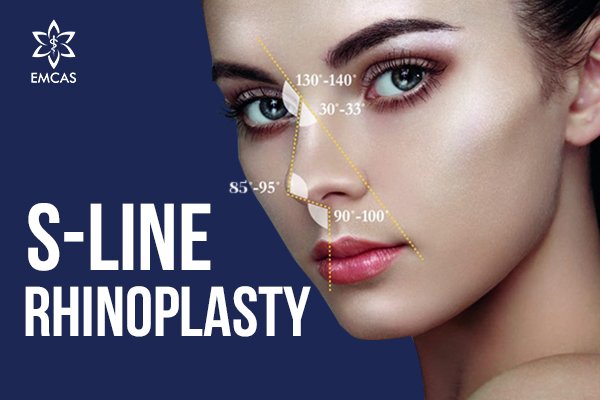
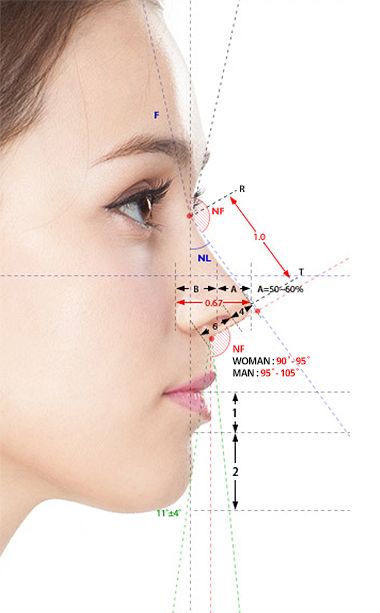
![]() Experienced, caring support: We are chosen by thousands of patients to provide them with the best care, from their consultation to surgery and throughout their entire aftercare. Our medical team and administration staffs at EMCAS are here to support you in every step of your journey.
Experienced, caring support: We are chosen by thousands of patients to provide them with the best care, from their consultation to surgery and throughout their entire aftercare. Our medical team and administration staffs at EMCAS are here to support you in every step of your journey.![]() We understand that your decision to go ahead with our high quality cosmetic or weight loss surgery shouldn’t be restricted by cost. That’s why we’ve made it easy to estimate the cost of your treatment during consultation and spread the cost with flexible payment options to suit you.
We understand that your decision to go ahead with our high quality cosmetic or weight loss surgery shouldn’t be restricted by cost. That’s why we’ve made it easy to estimate the cost of your treatment during consultation and spread the cost with flexible payment options to suit you.![]() Up to 80% of patients at EMCAS have had cosmetic or weight loss surgery after consultation and can share their experiences with you.
Up to 80% of patients at EMCAS have had cosmetic or weight loss surgery after consultation and can share their experiences with you.